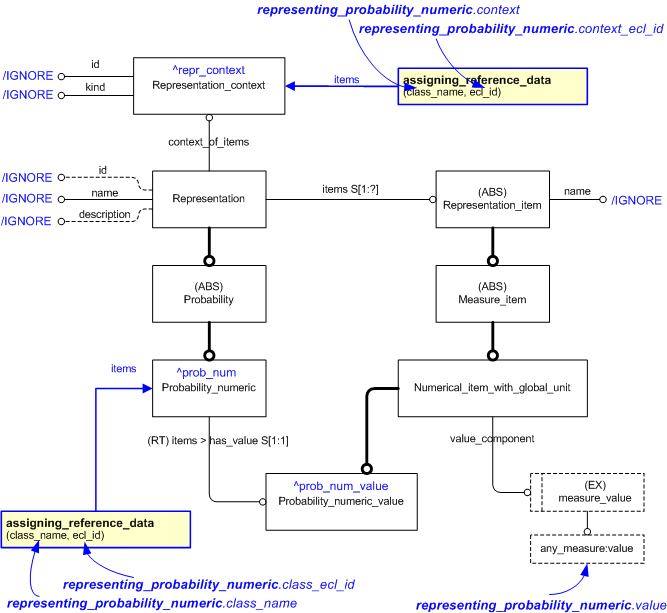| Template:— representing_probability_numeric (rep_prob_num) |
Date: 2009/06/08 08:46:04
Revision: 1.6
|
This section specifies the template representing_probability_numeric.
NOTE
An explanation of a template and the associated instantiation path is
provided in the
Template overview
section.
This template describes how to represent a numerical probability.
The EXPRESS-G diagram in
Figure
1
shows the templates and EXPRESS entities that are required
to represent the template
"representing_probability_numeric".
The text highlighted in blue shows the template parameters.
Figure 1 — An EXPRESS-G representation of the Information model for representing_probability_numeric
The graphic for the template to be used in other EXPRESS-G diagrams
is shown in Figure
2
below.
Figure 2 — The graphical representation of the representing_probability_numeric template
The following input parameters are defined for this template:
The value of the property. The datatype is always 'any_number_value'
and should not be registered together with the value, i.e. enter the
value as a number, without datatype.
The class name of the probability in which the probability value is expressed.
The following classes and their sub-classes can be used:
The identifier of the
External_class_library
storing the definition of the class referenced by the parameter @class_name.
The name of the class being used to classify the representation
context
(
Representation_context)
of the property.
The following classes and their sub-classes can be used:
The identifier of the
External_class_library
storing the definition of the class referenced by the parameter @context.
The following reference parameters are defined for this template:
Allow the
Probability_numeric
entity instantiated in this path to be referenced when this template is used.
%^target = $representing_probability_numeric.prob_num%
%^target = $representing_probability_numeric.prob_num_value%
Allow the
Representation_context
entity instantiated in this path to be referenced when this template is used.
%^target = $representing_probability_numeric.repr_context%
The following parameter combinations specify a uniqueness constraint:
Unique constraint: Unique Representation_context
Each instance of the
entity
(
Representation_context)
within the data set shall be uniquely identified
by a combination of the following parameters on this
template (representing_probability_numeric) namely:
context,
context_ecl_id.
The
instance is
referenced by the following template parameter:
repr_context.
The instantiation path shown below specifies the entities that are to be
instantiated by the template.
A description of templates and the syntax for the instantiation path is
provided in the
Templates Help/Information section.
-- Instantiate and bind Probability_numeric Probability_numeric%^prob_num =
Probability_numeric%
^prob_num.id = '/IGNORE'
^prob_num.name = '/IGNORE'
^prob_num.description = '/IGNORE'
-- Invocate template assigning_reference_data and assign the -- reference data to Probability_numeric /
assigning_reference_data(
class_name= @class_name,
ecl_id= @class_ecl_id,
items= ^prob_num)/
-- Instantiate and bind Representation_context Representation_context%^repr_context =
Representation_context%
^repr_context.id = '/IGNORE'
^repr_context.kind = '/IGNORE'
-- Invocate template assigning_reference_data and assign the -- reference data to Representation_context /
assigning_reference_data(
class_name= @context,
ecl_id= @context_ecl_id,
items= ^repr_context)/
-- Instantiate and bind Probability_numeric_value Probability_numeric_value%^prob_num_value =
Probability_numeric_value%
^prob_num_value.name = '/IGNORE'
^prob_num_value.value_component ->
@value-- Connect Probability_numeric with its context and its value
^prob_num.context_of_items ->
^repr_context
^prob_num.items ->
^prob_num_value
The following entities are instantiated with attributes as specified:
The instance diagram in Figure
3
shows an example of the EXPRESS entities and templates that are instantiated by the template:
/representing_probability_numeric(value='0.15', class_name='Normalized_numeric_probability', class_ecl_id='urn:plcs:rdl:sample', context='Probability_numeric', context_ecl_id='urn:plcs:rdl:sample')/
(an illustration of the consolidated representing_probability_numeric template is shown in
Figure
4 below.)
Figure 3 — Entities instantiated by representing_probability_numeric template
The instance model in STEP ASCII exchange file format (ISO 10303 Part
21 syntax) is:
#1 = PROBABILITY_NUMERIC_VALUE('/IGNORE',ANY_NUMBER_VALUE(0.15));
#2 = REPRESENTATION_CONTEXT('/IGNORE','/IGNORE');
#3 = PROBABILITY_NUMERIC('/IGNORE','/IGNORE','/IGNORE',#2,(#1));
#5 = CLASSIFICATION_ASSIGNMENT(#6,(#3),'/IGNORE');
#6 = EXTERNAL_CLASS('/NULL','Normalized_numeric_probability','/IGNORE',#7);
#7 = EXTERNAL_CLASS_LIBRARY('urn:plcs:rdl:sample','/IGNORE');
#9 = CLASSIFICATION_ASSIGNMENT(#10,(#2),'/IGNORE');
#10 = EXTERNAL_CLASS('/NULL','Probability_numeric','/IGNORE',#7);
The instance diagram in
Figure
4
shows the graphic symbol for the template that is to be
used in other instance diagrams. The example template is:
/representing_probability_numeric(value='0.15', class_name='Normalized_numeric_probability', class_ecl_id='urn:plcs:rdl:sample', context='Probability_numeric', context_ecl_id='urn:plcs:rdl:sample')/
Figure 4 — Instantiation of representing_probability_numeric template
Characterizations
No common characterizations of the template
representing_probability_numeric
have been identified. However, the ISO 10303-239 EXPRESS model
may enable other assignments to the entities instantiated by the template.




